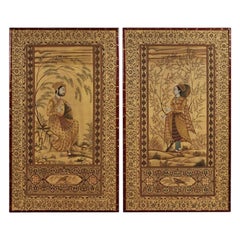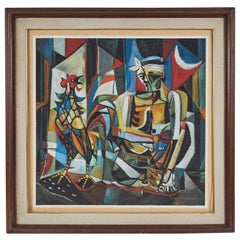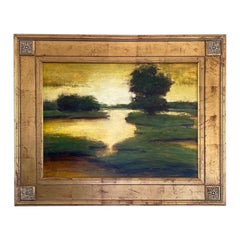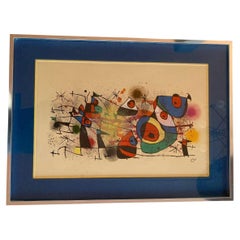Hollis Pasadena Paintings and Screens
to
2
2
1
2
1
1
1
1
1
1
2
2
2
Pair of Mughal Style Portait Panels
Located in San Marino, CA
Pair Hand-Painted Indian Portait Panels from the 20th Century.
Category
20th Century Italian Paintings and Screens
Materials
Wood
$16,000 / set
Modern Oil on Canvas Cubist “Boy with Rooster” Painting
Located in San Marino, CA
A modern cubist style painting in the manner of Vicente Manansala (1910-1981) of the Philippines. Heavy texture, paint on canvas. 36" x 36" fr...
Category
20th Century Philippine Modern Paintings and Screens
Related Items
The Marshland Farmington by Seth Winegar '1999'
Located in San Diego, CA
Beautiful original landscape scene by acclaimed artist Seth Winegar. This piece titled “Marshland Farmington” from 1999 showcases the light in nature from...
Category
1990s American Other Paintings and Screens
Materials
Paint
Original Lithograph Joan Miró, Ceramiques, 1974
By Joan Miró, Maeght
Located in San Diego, CA
Joan Miró, Ceramiques, is an original Lithograph made in 1974. It has a printed signature in the lower right of the image. Published and Printed by Maeght, Paris. M.928.
Joan Miró w...
Category
Vintage 1970s French Expressionist Paintings
Materials
Chrome
Mughal Miniature of Shah Jahan on a Leisure Stroll, 19th Century
Located in Islamabad, PK
The Mughal miniature painting, meticulously crafted with a single-hair brush on fine rice paper, captures a serene and elegant scene of Emperor Shah Jahan taking a leisurely stroll o...
Category
Antique Mid-19th Century Indian Anglo Raj Paintings and Screens
Materials
Paint, Paper
Framed Antique Tibetan Buddhist Thangka
Located in Atlanta, GA
A stunning antique Tibetan Thangka with an embroidered border, circa mid to late 19th Century. It depicts Yamantaka or Vajrabhairava, a wrathful manifestation of Manjusri, the bodhisattva of wisdom, and in other contexts functions as a dharmapala, or 'Dharma-protector'. The buffalo head deity Vajrabhairava is one of the three principal meditation deities of the Gelug School. He is shown with nine faces in the Yab Yum...
Category
Antique 19th Century Tibetan Tibetan Paintings and Screens
Materials
Textile, Acrylic
Japanese Showa Two Panel Screen Pair of Tethered Hawks
Located in Rio Vista, CA
Captivating Japanese Showa period two-panel folding byobu screen featuring a pair of hawks or birds or prey tethered to a wooden perch. The painting has ink and natural colored pigme...
Category
20th Century Japanese Showa Paintings and Screens
Materials
Brass
Mughal School Indian Miniature Painting of Radha-Krishna
Located in Chicago, IL
This 19th-century Indian miniature painting is composed in the Mughal style and depicts a meeting of the Hindu god Krishna and his shakti Radha, also known as the Supreme Goddess. To...
Category
Antique 19th Century Indian Paintings
Materials
Paint, Paper
Pair of Painted Chinoiserie Panels
Located in New York, NY
Pair of 1960s painted panels depicting trees and birds.
Measurements:
Height: 44"
Width: 26.25".
Category
Vintage 1960s Chinese Paintings and Screens
Materials
Wood
Pair of Japanese Edo Six Panel Screens the Seven Sages
Located in Rio Vista, CA
Fantastic pair of 19th century Japanese late Edo/early Meiji period six-panel screens titled The seven sages of the bamboo grove. The Kano school screens...
Category
Antique 19th Century Japanese Edo Paintings and Screens
Materials
Brass, Gold Leaf
Pair Chinese Silk Foral Panels
Located in Douglas Manor, NY
Pair silk floral panels set in wood frames
each panel 22 x 47"
Combined panels 44" x 47".
Category
Vintage 1960s Paintings and Screens
Materials
Silk, Hardwood
Antique Oil on Canvas Painting of a Venetian Harbor
Located in Dallas, TX
Very fine antique painting of a busy Venetian harbor. Featuring beautiful architecture, boats, and figures. A wonderful piece of art! Circa 1920.
58w x 42h
Category
Early 20th Century Paintings and Screens
Materials
Canvas
Vintage 1980s Lee Reynolds Oil on Canvas Painting Depicting "A Zeal of Zebras"
By Lee Reynolds
Located in Philadelphia, PA
A large oil on canvas (40" tall x 50" wide) depicting a group on Zebra, AKA "A Zeal of Zebras". This striking modern painting is well made. There is a thickness to the paint that add...
Category
Vintage 1980s American Modern Paintings and Screens
Materials
Canvas, Paint
$2,000
H 40 in W 50 in D 1.5 in
Large Pichhavai Painting of Krishna with Female Gopis Dancing
By Rajhastani
Located in North Hollywood, CA
A large Pichhavai painting of Krishna with female Gopis dancing
Krishna playing flute on a bed of lotus, the composition is enclosed in a lush gree...
Category
Early 20th Century Indian Folk Art Paintings and Screens
Materials
Silk



